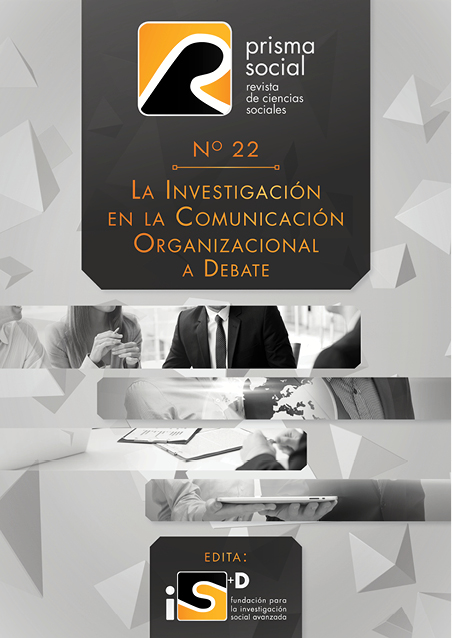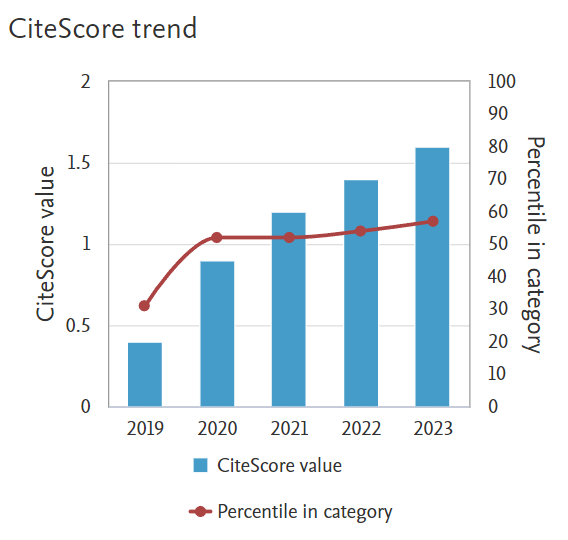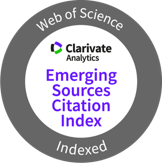Universidad y medios sociales. Gestión de la comunicación en la universidad española
Palabras clave:
universidad, branding, social mediaResumen
La implantación y crecimiento de los medios sociales en la sociedad deja poco margen de elección a las universidades. Teniendo en cuenta el número de usuarios/as de estos medios, parecen ser una herramienta fundamental para fortalecer las relaciones de las universidades con sus públicos (Cancelo-Sanmartin & Almansa-Martinez, 2013). Quizás por esto las redes sociales están siendo un creciente objeto de estudio en el contexto de la investigación universitaria (Clark, Fine, & Scheuer, 2017).
La presencia corporativa de las universidades españolas en los medios sociales es una realidad pero, no es suficiente con crear un perfil corporativo en las redes más populares sino que dicha presencia debe responder a objetivos estratégicos.
En el presente estudio se ha realizado una encuesta a los/as responsables de la comunicación digital de 17 universidades españolas a los que se preguntó por la estrategia de comunicación, los públicos y los contenidos de las comunicaciones en los medios sociales. Los resultados indican una importancia creciente de estos medios en los planes de comunicación y confirman que las universidades buscan comunicarse, principalmente, con los/as estudiantes.
Descargas
Citas
Arquero, J.L & Romero-Frías, E. (2013). Using social network sites in Higher Education: an experience in business studies, Innovations in Education and Teaching International, 50 (3)3, 238-249, DOI: 10.1080/14703297.2012.760772
Benson, V, Saridakis, G. & Tennakoon, H. (2015). Purpose of social networking use and victimisation: Are there any differences between university students and those not in HE? Computers in Human Behavior, 51, 867–872.
Cancelo-Sanmartin, M.; Almansa-Martinez, A. (2013). Communication strategies in social networks. Comparative Study between Spain and Mexico universities. Historia y Comunicación Social, 18 (esp), 423-435.
Chapleo, C.; Carrillo Durán, MV. & Castillo Díaz, A. (2011). Do UK universities communicate their brands effectively through their websites?, Journal of Marketing for Higher Education, 21(1), 25-46, DOI: 10.1080/08841241.2011.569589
Clark, M., M.B. Fine, y C.L. Scheuer (2017). Relationship quality in higher education marketing: the role of social media engagement. Journal of Marketing for Higher Education, 27 (1), 40-58.
European Commission (2008). Higher Education Governance in Europe. Policies, structures, funding and academic staff. Bruselas: Eurydice.
Fournier, S. and Avery, J. (2011). The uninvited brand. Business Horizons, 54 (3), 193-207.
García-Galera, M., & Fernández-Muñoz, C. (2016). Si lo vives, lo compartes. Cómo se comunican los jóvenes en el mundo digital. Barcelona: Fundación Telefónica.
Gómez, M.; Roses, S. & Farias, P. (2012). The Academic Use of Social Networks among University Students. Comunica Journal, 38, 131-138. Disponible en: http://www.revistacomunicar.com/index.php?contenido=detalles&numero=38&articulo=38-2012-16
González-Díaz, C. Iglesias-García, M. & Codina, Ll. (2015). Presencia de las universidades españolas en las redes sociales digitales científicas: caso de los estudios de comunicación. El Profesional de la Información, 24(5), 640-647. doi:10.3145/epi.2015.sep.12
IAB (2016): Estudio anual de redes sociales. Disponible en: http://www.iabspain.net/wp-content/uploads/downloads/2016/04/IAB_EstudioRedesSociales_2016_VCorta.pdf
Kaplan, A. M., & Haenlein, M. (2010). Users of the world, unite! The challenges and opportunities of social media. Business Horizons, 53(1), 59–68.
Karami, S. & Naghibi, H.S. (2014). Social Media Marketing strategies for small to medium enterprises. International Journal of Sales & Marketing Management Research and Development, 4 (4), 11-20.
Karjaluoto, H.; Mustonen, N. & Ulkuniemi, P. (2015). The role of digital channels in industrial marketing communications. Journal of Business & Industrial Marketing, 30 (6), 703-710 http://dx.doi.org/10.1108/JBIM-04-2013-0092
Killian, G. & McManus, K. (2015). A marketing communications approach for the digital era: Managerial guidelines for social media integration. Business Horizons, 58 (5), 539–549
Knight, CG. & Kaye, L.K (2016). ‘To tweet or not to tweet?’ A comparison of academics’ and students’ usage of Twitter in academic contexts, Innovations in Education and Teaching International, 53(2), 145-155, DOI: 10.1080/14703297.2014.928229
Labrecque, L.I (2014). Fostering Consumer–Brand Relationships in Social Media Environments: The Role of Parasocial Interaction. Journal of Interactive Marketing, 28 (2), 134–148. doi:10.1016/j.intmar.2013.12.003
Lacayo-Mendoza, A. & de Pablos-Heredero, C. (2016). Managing relationships and communications in higher education efficiently through digital social networks: The importance of the relational coordination model. DYNA 83 (195), 138-146.DOI: http://dx.doi.org/10.15446/dyna.v83n195.49296
Lafuente-Ruiz-de-Sabando, A., et al. (2018). A review of higher education image and reputation literature: Knowledge gaps and a research agenda. European Research on Management and Business Economics, 24 (1), 8-16 http://dx.doi.org/10.1016/j.iedeen.2017.06.005
Lee, K. (2017). Rethinking the accessibility of online higher education: A historical review. The Internet and Higher Education, 33(1), 15-23. doi: http://dx.doi.org/10.1016/j.iheduc.2017.01.001
Lipiäinen, H.S.M & Karjaluoto, H. (2015). Industrial branding in the digital age, Journal of Business & Industrial Marketing, 30 (6), 733 – 741. http://dx.doi.org/10.1108/JBIM-04-2013-0089
Lopes, P.& Varela, M. (2014). Global university environment – which marketing strategies?, INTED2014 Proceedings, 3086-3094.
Marcelino Mercedes, G. V. (2015). Migración de losjóvenes españoles en redes sociales, de Tuenti a Facebook y de Facebook a Instagram. La segunda migración, Icono 14, 13, 48-72. doi: 10.7195/ri14.v13i2.821
Matsuo, H.; McIntyre, K.;Tomazic, T. & Katz, B. (2004). The Online Survey: Its Contributions and Potential Problems. Proceedings of the Survey Research Methods Section, American Statistical Association. Disponible en: http://www.amstat.org/sections/srms/Proceedings/y2004/files/Jsm2004-000440.pdf
Ministerio de Educación (2017). Sistema Integrado de Información Universitaria . Disponible en: http://www.mecd.gob.es/educacion-mecd/areas-educacion/universidades/estadisticas-informes/siiu.html
Omilion-Hodges, L.M & McClain, K.L. (2016). University use of social media and the crisis lifecycle: Organizational messages, first information responders’ reactions, reframed messages and dissemination patterns. Computers in Human Behavior, 54, 630–638. doi:10.1016/j.chb.2015.06.002
Pergolino, M, Rothman, D., Miller, J. & Miller, J. (2012). The Definitive Guide to Social Marketing. A Marketo Workbook. Disponible en: http://www.slideshare.net/ntdlife/definitive-guidetosocialmarketing-32648238.
Plewa, C.; Ho, J.; Conduit, J. & Karpen, I.O. (2016). Reputation in higher education: A fuzzy set analysis of resource configurations. Journal of Business Research, 69(8):3087-3095. http://dx.doi.org/10.1016/j.jbusres.2016.01.024
Raj, E. D., & Babu, L. D. (2017). An enhanced trust prediction strategy for online social networks using probabilistic reputation features. Neurocomputing, 219, 412-421.
Shields, R. (2016). Following the leader? Network models of “world-class” universities on Twitter. Higher Education, 71 (2), 253-268. DOI 10.1007/s10734-015-9900-z
Snoeijers, EM , Poels, K, C & Nicolay, C. (2014). #universitycrisis: The Impact of Social Media Type, Source, and Information on Student Responses Toward a University Crisis, Social Science Computer Review, 32 (5), 647-661 [doi>10.1177/0894439314525025]
Szwajca, D. (2017). The role of social media in corporate reputation management. The results of the polish enterprises. Foundations of Management, 9, 161-174. DOI: 10.1515/fman-2017-0013
Valerio, G., Herrera-Murillo, D., Villanueva, F., Herrera-Murillo, N. and Rodríguez-Martínez, M. C. (2015). The Relationship between Post Formats and Digital Engagement: A Study of the Facebook Pages of Mexican Universities. RUSC. Universities and Knowledge Society Journal, 12(1), 50-63. doi: http://dx.doi.org/10.7238/rusc.v12i1.1887
Zailskaite-Jakste, L. & Kuvykaite, R. (2012). Implementation of Communication in Social Media by Promoting Studies at Higher Education Institutions. Inzinerine Ekonomika-Engineering Economics, 23(2), 174-188. http://dx.doi.org/10.5755/j01.ee.23.2.1550
Descargas
Publicado
Cómo citar
Número
Sección
Licencia
Los derechos de edición pertenecen a la Fundación iS+D para la Investigación Social Avanzada, entidad que edita la Revista Prisma Social, y es necesario su permiso para cualquier reproducción. En todo caso, será necesario citar la procedencia de cualquier reproducción total o parcial.
La publicación de artículos o reseñas en la Revista Prisma Social no da derecho a remuneración alguna.
Política de acceso abierto
La publicación de la Revista Prisma Social y su difusión se realiza de forma abierta a través de Internet.
La Revista Prisma Social ofrece acceso libre y abierto inmediato a su contenido de forma totalmente gratuita con el fin de hacer llegar la investigación científica a toda la sociedad y con el objetivo de crear una cultura reflexiva encaminada a la comprensión de los comportamientos sociales desde una perspectiva global.
Todos los contenidos digitales de la Revista Prisma Social son de acceso libre y gratuito y se publican bajo una licencia de Creative Commons:

está bajo una licencia de Creative Commons Reconocimiento-NoComercial-SinObraDerivada 3.0 España License.
Creado a partir de la obra en www.isdfundacion.org
Bajo esta licencia, está permitida la reproducción y difusión de los contenidos de la revista con fines educativos o de investigación, sin ánimo de lucro, siempre y cuando estos no se modifiquen, se cite la procedencia (Prisma Social, Revista de ciencias sociales), y la autoría.
Esta licencia a la que se acoge la Revista Prisma Social permite copiar, distribuir, exhibir los textos e imágenes de la revista, siempre que se cumplan las siguientes condiciones:
- Reconocimiento: Debe reconocerse y respetarse la autoría de la obra de la manera especificada por el autor y la entidad editora (Revista Prisma Social – Fundación iS+D).
- No comercial: No se puede utilizar esta obra para fines comerciales.
- No derivados: No se puede alterar, transformar o generar una obra derivada a partir de esta obra.
Se deberán establecer claramente los términos de esta licencia para cualquier uso o distribución de los documentos. Se podrá prescindir de cualquiera de estas condiciones si se obtiene el permiso expreso del autor/a.
Desde la Revista de Prisma Social se permite y se invita a los/as autores/as a ampliar la visibilidad, alcance e impacto de sus artículos publicados en la revista mediante la redifusión (auto-archivo) de los mismos en:
1. Sus espacios web personales (web, blog, redes sociales, foros científicos, etc.).
2. Archivos abiertos institucionales (archivos universitarios, Hispana, Europeana, etc.).
3. Redes sociales de naturaleza académica y científica (ResearchGate, Academia.edu, Getcited.org).
Se requiere que en dichas publicaciones se detallen todos los datos bibliográficos de la publicación.
Para más información, puede descargar y consultar las Condiciones de Publicación:

















